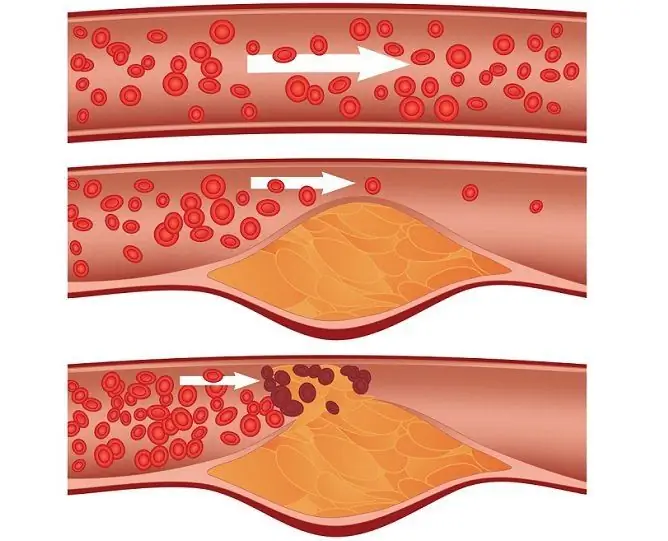- Author Rachel Wainwright [email protected].
- Public 2023-12-15 07:39.
- Last modified 2025-11-02 20:14.
Neurogenic bladder
Neurogenic bladder is a term used for a whole complex of urinary disorders, which are united by one cause, namely, a malfunction of the nervous system, the part of it that is responsible for urine excretion. As with other diseases of the nervous system, it can occur in both adults and children.
Causes of a neurogenic bladder

There can be many reasons for the development of a neurogenic bladder. Normal voluntary emptying of the bladder is multilevelly regulated, involving a large number of nerves. Failure at any stage of complex regulation, ranging from stress experienced, brain diseases, and ending with a violation of the innervation of the bladder sphincter, can cause symptoms of a neurogenic bladder. The most common cause of the development of pathology in adults is trauma and diseases of the spinal cord. A neurogenic bladder in children, in addition to these reasons, can be a manifestation of a malformation of the spinal cord or urinary tract, as well as a consequence of birth trauma.
Symptoms of a neurogenic bladder
Urination consists of two stages, an accumulation phase and an excretion phase. At the stage of accumulation, urine from the ureters enters the bladder and accumulates there until about 150 ml is collected. After that, normally, a person feels the urge to urinate, a relaxing group of bladder nerves is triggered, and the excretion stage follows. Disorders manifesting as neurogenic bladder can occur during both accumulation and excretion of urine. There are two types of neurogenic bladder, hyperactive and hypoactive (hypertensive and hypotonic).
An overactive bladder is characterized by:
- Frequent urge with a small amount of urine;
- Strong tension in the muscles of the bladder, sometimes even causing urine to flow back from the bladder into the ureters (vesicoureteral reflux);
- Urgent urge to urinate, when suddenly there is an urge of such force that the patient cannot endure to the toilet;
- Nocturia (frequent urination at night).
A hypoactive bladder manifests itself on the contrary, the absence of normal urination with a full and even overflowing (amount of urine may exceed 1500 ml) bladder.
In addition, a symptom of a neurogenic bladder is a lack of urinary control. This may be the absence of "mature urination" in children at the age when this reflex should already be formed or the loss of controlled voluntary urination in adults.
Symptoms of a neurogenic bladder directly depend on where in the nervous control the failure occurred, this also affects the constancy (constant, periodic, episodic) and the severity of the manifestations of the disease.
Diagnostics of the neurogenic bladder
Diagnosis of neurogenic bladder begins with a thorough history taking. The patient is invited to keep a diary of urination for several days, noting the time and amount of fluid drunk. When diagnosing a neurogenic bladder in children, parents are encouraged to keep a diary, in addition, it turns out if there are hereditary prerequisites for the development of such a disease, as well as the history of childbirth.
Since the symptoms of a neurogenic bladder are similar to symptoms of urinary disorders in inflammatory diseases of the genitourinary system, a complete examination of the organs of this system for the presence of infection is carried out. This is a laboratory study of urine using various functional tests (according to Zimnitsky, according to Nechiporenko, etc.). An examination of the organs of the genitourinary system is also carried out using medical imaging methods (ultrasound, MRI, cystoscopy, X-ray examination using X-ray contrast agents) to detect symptoms of inflammation or anomalies in the structure of the urinary tract. Only by completely eliminating the inflammatory process can we talk about a neurogenic bladder.
If the absence of diseases of the urinary organs is established, a neurological examination is performed for the presence of pathologies of the spinal cord and brain. For this, various techniques are used, including CT and MRI.
In some case, even after a complete and thorough medical examination, it is not possible to establish the cause of the neurogenic bladder; in this case, they speak of a neurogenic bladder with an unclear etiology.
Treatment of neurogenic bladder

Treatment for neurogenic bladder consists of drug and non-drug therapy. Treatment is performed by either a urologist or a neurologist, depending on the established cause of the neurogenic bladder. An overactive bladder responds better to therapy. In this case, drugs that have a relaxing effect on the muscular apparatus of the bladder (anticholinergics, adrenergic blockers), as well as drugs that improve its blood supply, are prescribed as a drug part of the therapy, since blood circulation is often impaired as a result of spasm. From non-drug means of treating neurogenic bladder, exercise therapy is used, including special training exercises for the pelvic floor muscles, physiotherapy methods, and normalization of drinking and sleep. If psychogenic causes of a neurogenic bladder are established, a course of psychotherapy gives a good result.
The hypoactive type of neurogenic bladder is more difficult to treat. Due to stagnation in the bladder, there is a high risk of developing secondary lesions of the urinary system and infection. The bladder overstretches, loses its elasticity, the accumulated urine irritates its walls and can be thrown into the ureters and from there into the kidneys, causing inflammation. For the treatment of a neurogenic bladder with signs of hypotension, drugs are used to prevent the development of the inflammatory process, as well as physiotherapy, and methods of training the muscles of the pelvic floor and bladder. If the treatment is ineffective, it is necessary to take measures for urine diversion, for which bladder catheterization is used.
In the event that treatment with conservative methods has been unsuccessful, surgical treatment of a neurogenic bladder is sometimes indicated. Depending on the reasons, it can be correction of the nervous apparatus of the bladder, or plastic surgery of the musculo-ligamentous apparatus.
YouTube video related to the article:
The information is generalized and provided for informational purposes only. At the first sign of illness, see your doctor. Self-medication is hazardous to health!






